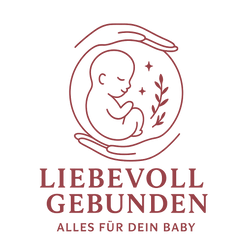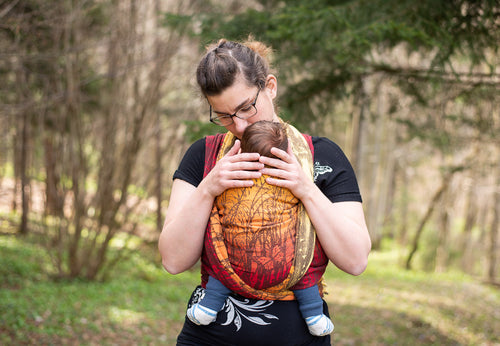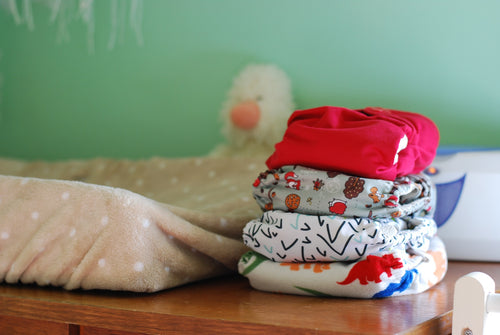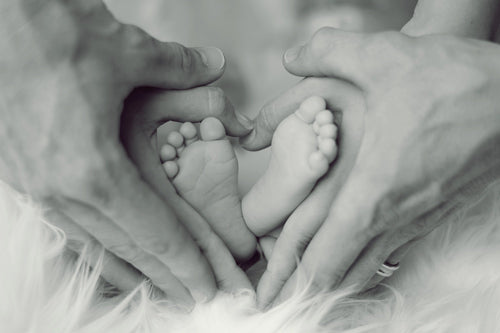Proper baby handling for hip dysplasia
Feb 22, 2022
This is how you support your baby’s healthy hip maturation!
Today I'll show you what you can easily integrate into your everyday life so that you can promote your baby's healthy hip development. But first, a quick bit of information about what an immature hip actually is:
Every baby is born with an immature hip - because hip development is not complete until around the age of 2. The so-called infant sonography is used to detect congenital hip dislocations in infants at an early stage.
In the womb, your baby's legs are bent - usually more than 90°. The further the pregnancy progresses and the less space your child has in the stomach, the stronger this bend becomes, so that your baby can no longer pull its legs any further. This posture - as we know from research - is ideal for the development of the child's hips.

Photo: Suhyeon Choi
Once your baby is born, you can still observe this bending: when you put your baby down or pick it up, it automatically pulls its legs up - like a little frog. However, if the hip socket is not sufficiently strong, the femoral head can slowly slip upwards. To the extent that dislocation can occur. That's why it's very important to make sure that the sockets are supported after birth.
Because we humans are so-called “physiological premature births”, we have to do one thing above all: carry our children! In such a way that a correct squatting and spreading posture is present. Only then will the baby's legs be bent to 90 degrees or more, only spread slightly and cannot be stretched. So the ideal position for the child's hip development!
We read about the squatting spread position again and again - how important it is and that it has to be absolutely correct so that the hips of the newborn baby are not damaged. However, there is no (!) evidence that a “healthy” hip of a newborn can be damaged if it is not carried in the squatting spread position. Apart from that, a lot of babies who are more likely to lie in a stroller would probably have damaged hips and hip problems. Nevertheless: if we already know how to carry things “correctly”, this should also be applied.
What does the squat-spread position look like?

The squatting position looks like an “M” when we look frontally at the baby in the wrapped sling or a baby carrier. The knees are higher than the bottom - approximately at baby's belly button height - and the bottom is therefore lower. You can also compare it to a frog sitting on its lily pad.
Photo: Taisiia Shestopal
We know from various research that in peoples where children are mostly carried in a sling, hip dislocations are almost non-existent. Wearing it for several hours a day ensures that the muscles press over the femoral head into the socket - hydrostatic pressure is created in the cartilaginous part of the joint, which promotes ossification of the hip socket.
When you carry it, you can not only give security, warmth, closeness and security: you ensure that your baby's hips can mature optimally!
What does swaddling have to do with hip development?
Another point that I would like to address as a cloth diaper consultant: incorrect handling often occurs when changing diapers! Pulling the child up by the feet also leads to an unnatural stretch. This can also be painful. In addition, it does not correspond to the natural movement sequence. The term “kinesthetics” is the study of the sensation of movement. “Infant Handling” means touching the newborn. And this is exactly where we come in: the handling and touching of newborns in terms of changing, carrying, etc. - also for healthy hip maturation!
Not only that we should talk to our baby when we change him. We also have to enable our child to follow their natural movements so that their natural movement is not disturbed. We also show our child: “I respect you and your body!” This way, your baby experiences self-efficacy and makes him or her happy. Trust and loyalty are also strengthened, because meeting on an equal level is very important for this!
 Photo Kelly Sikkema
Photo Kelly Sikkema
How do I change a baby correctly?
Swaddling can also support the healthy maturation of the hips and protect your baby's musculoskeletal system - but only if it is done correctly!
Changing begins as soon as you lay it down - wrap your child around the back with one hand and hold the bottom with the other. Place your baby over his feet (and not his back!). Gently roll your baby onto the changing mat - over the side! First put the feet down, then the bottom, then the entire side of the child until all of the weight is on the surface. Only when your child is lying on their side do you turn them onto their back.
Since babies initially turn to the side and do not sit upright, this laying down corresponds to the natural movement pattern.

Photo Brooklyn
You should only give your baby the impulse to turn to the side so that he can understand and understand movement. Later, you can also offer your baby a finger to hold onto to turn to the side.
Even when getting dressed, turning to the side can be a lot better and more comfortable for your baby and support it in its natural movement. It is absolutely beneficial for the hips if the child is not pulled up by the feet.
Ideally, picking up the baby should be done in the same way as putting it down. First turn to the side, then lift your upper body up, then hug your bottom and bring it into a “standing” position over your feet.

Photo David Veksler
How should I integrate this into my everyday life with a baby?
Some situations such as time pressure and stress often do not allow for this conscious approach when changing diapers. Make sure that you always consciously take the time to gently put the child down and change him or her. The more often you internalize and practice this routine, the more natural it becomes. At some point you'll do it automatically without even thinking about it!
When carrying it, it is important that you use the right system for you. During a babywearing consultation you can find out what suits you and what you feel most comfortable with. It is important for your baby to be able to squat, that the back is supported and has a slight curve. Supporting the small head and clear airways is also one of the most important points.
In any case, get help and support from an experienced specialist if you need it! I hope you can implement the tips mentioned above and look forward to hearing from you if you have any questions.
All love,
Tatyana








